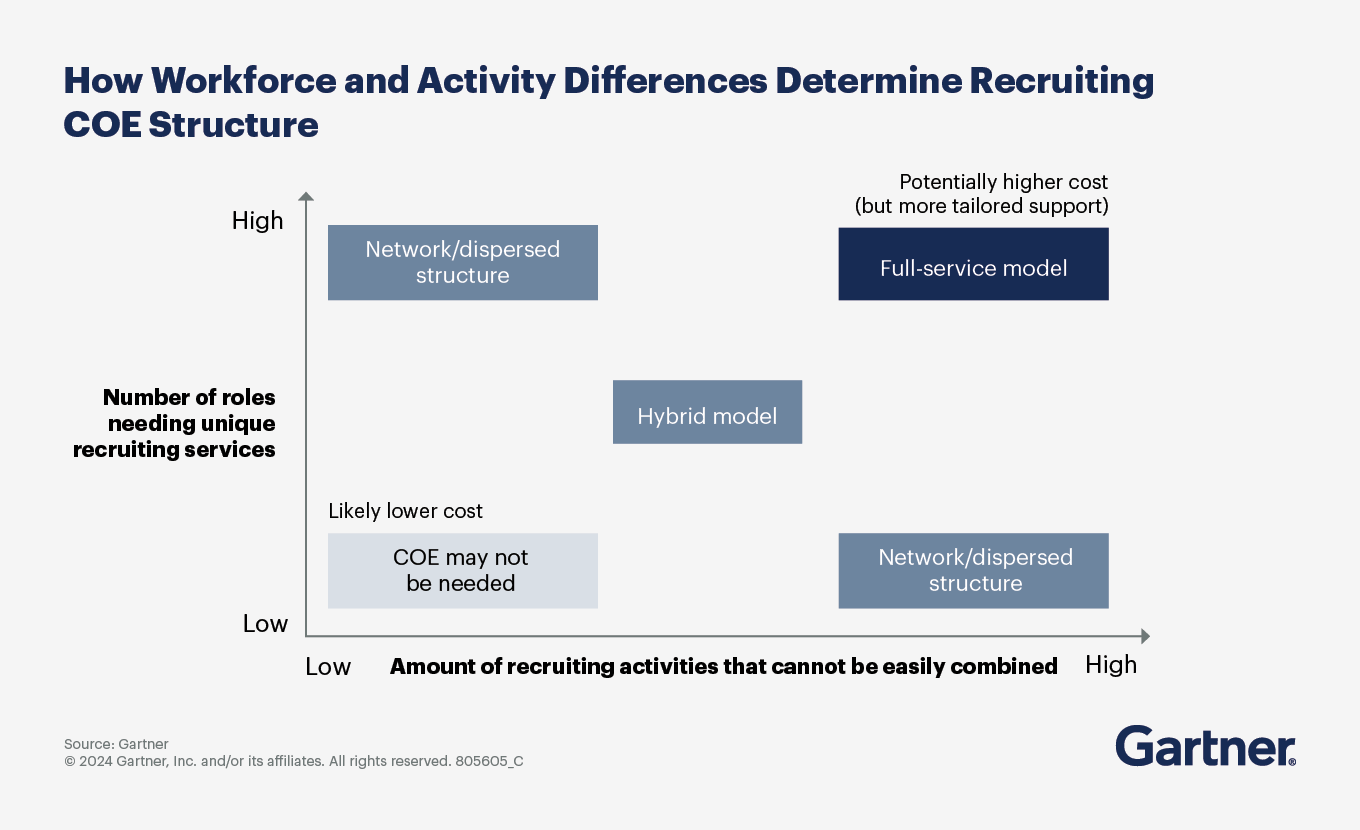Empower HR leaders with insights to overcome market challenges and attract top talent.
- Gartner client? Log in for personalized search results.
Craft an Effective Recruiting Strategy to Hire Top Talent in 2025
Leadership vision for 2025: Top priorities for recruiting leaders
Recruiting leaders face mounting pressures in 2025, from meeting CEO-driven growth targets to overcoming resource constraints and talent shortages. Download this guide to help you tackle these challenges head-on, ensuring your team is positioned for impact.
Reshape recruiting functions, delivering greater efficiency and value.
Expand talent pipelines that align with CEO growth expectations.
Integrate tech innovations effectively, enhancing recruiting delivery.
Build a recruiting strategy that can flex in a volatile climate
Jump-start corporate performance and future-proof against a challenging labor market with a long-term recruiting strategy that attracts top talent. Begin by focusing on the following areas:
Labor Market Intelligence
Recruiting Resilience
Recruiting Excellence
Understand how to improve the recruiting strategy and adapt to changing needs
The pace of change around organizations’ skills needs shows no signs of slowing. This impacts the way HR leaders approach recruiting strategy and talent acquisition. Faced with a range of talent options — from building to buying to borrowing — a clear view of cost, time, competitiveness, talent availability and cultural fit is essential.
Use labor market intelligence to choose the best recruiting strategy for current business needs. Labor market intelligence moves beyond simple data trends by telling the story behind the data so you can compare resources (like talent supply), candidate sourcing, competition rates and hiring difficulty when deciding on your recruiting strategy.
Use labor market intelligence to define critical skills needs
When resources are limited, identify the skills needs of critical business units and help leaders meet them by adding the following actions to your recruiting strategy:
Gather “good-enough” skills data. Gather enough information to inform skills decisions today rather than waiting too long for comprehensive skills data. This will enable you to keep up with changing skills, align with HR’s strategy and better meet your organization’s needs.
Balance frontline and leader perspectives on skills. Combine your expertise on talent with internal feedback from a diverse set of stakeholders to get a more accurate view of skills needs.
Use market intelligence for skills context. External market data fills in gaps that arise from “good-enough” skills data collection. By using diverse data sources, you’ll gain a more well-rounded view of your organization’s and industry’s skills needs, enhancing employer branding.
Course-correct regularly. Commit to regular, consistent check-ins with a cross-organizational network of skills stakeholders to incorporate viewpoints from throughout the business and HR. This will allow you to proactively identify changes in workforce needs and respond effectively, and improve the candidate experience.
Use labor market intelligence to analyze internal versus external skills markets
Shaping your recruiting strategy around critical skills requires a broad overview of internal skills assets — both temporary and permanent — and external markets for labor, services and technologies.
Internal skills market: Build a “good-enough” inventory of critical skills across the organization and update it regularly. Use available information sources to attribute skills to employees. Possible information sources include:
Self-assessments
Analysis of talent data (job moves, talent profiles and résumés)
Employees’ professional profiles on external sites (such as LinkedIn)
Manager performance reviews or observations
360-degree assessments
Surveys or vendor-provided assessments
External skills markets: Use labor market intelligence to assess the external labor market for the availability of critical skills. Explore the following:
Skills adjacencies (i.e., skills closely related to a critical skill) to help assess the feasibility of developing or redeploying talent
Talent supply to assess the availability of skills in the external market
Location analysis to review the feasibility at current and alternative locations of buying talent
Competitive pressure to gauge the feasibility of competing for and hiring critical talent
Hiring difficulty to estimate the time frame required to fulfill talent needs
Build a resilient recruiting strategy to thrive in a volatile hiring landscape
Only 22% of recruiting executives have visibility into their hiring needs for the current year — and 78% of recruiting leaders face stagnant or shrinking budgets in the coming year.
To build a recruiting strategy that guides business leaders toward the best talent choices, take the following actions:
Review talent needs when strategies shift. Business pauses, canceled initiatives and sudden accelerations demand the ability to quickly realign your recruiting strategy. Focus on the following:
Identify critical workflows and tasks. Talent gaps can pause workstreams, delay business outcomes and prevent growth at critical moments. Identify critical workflows and tasks, and then work with hiring teams to identify the skills needed to maintain these workflows.
Pre-identify responses to potential challenges through scenario planning. Hold scenario planning discussions — for example, around a potential hiring freeze — to plan how to engage recruiters during a downturn. Troubleshoot responses to past disruptions and adjust your recruiting strategy accordingly.
Track labor market shifts. Recruiting teams that gather labor market intelligence as part of their recruiting strategy are more likely to see improved quality of hire and hiring process efficiency.
Prioritize internal talent. In times of economic volatility, retaining key talent is critical. To offset a competitive environment, integrate the following into your recruiting strategy:
Build internal mobility into conversations with hiring managers.
Proactively remind employees of internal growth opportunities to help them stay engaged and envision long-term opportunities.
Give recruiters access to internal candidates. Only 15% of recruiting executives report their recruiters can freely contact any employee at their organization regarding an internal opening.
Encourage temporary, project-based mobility, where management teams move employees to high-need areas to address emergent needs and provide employees with opportunities to upskill based on their interests and skills.
Explore alternative hiring strategies. Backfilling is particularly challenging in today’s hiring environment, as organizations must not only compete with peers for talent but also adapt to changing employee lifestyle preferences and ambitions. Include alternative talent sources in your recruiting strategy to maximize existing resources, optimize recruiting budgets and increase efficiency.
Explore “buy, then build” strategies to hire talent with adjacent skills, then upskill them into the role. For example, midcareer apprenticeships can help organizations hire candidates with transferable skills and train them to succeed in a new career.
Implement a talent mix of contingent workers, freelancers, crowds and partners to meet critical talent needs.
Solidify delivery on recruitment strategy with a recruiting center of excellence
Seventy-six percent of HR leaders anticipate cost-saving measures in the next three months, underscoring the need to build a recruiting strategy with more efficient, responsive forms of staffing. For recruitment functions looking to standardize or scale, a recruiting center of excellence (COE) can be a highly effective solution.
A recruiting COE is staffed with employees who have specific expertise in key capabilities. The COE consolidates their specialized knowledge, defines how things should operate in its specialist areas and provides the infrastructure to help this happen.
Consider a COE when you want to:
Reduce duplication of the same activities
Increase specialization in areas that are harder for generalists to pick up on
Ensure consistent delivery
Take distracting work off a recruiter’s plate
To introduce a COE into your recruiting strategy, begin by doing the following:
Step 1: Define purpose and scope
Purpose: COEs typically start out small and reactive and then evolve into a larger team with a broader scope and more agile support. Start by asking:
What will the COE achieve, and how is it aligned to recruiting strategy?
What capabilities need additional expertise and development?
What can the COE realistically achieve over the short term?
What is the long-term vision, and how will the COE evolve?
Next anticipate risks and challenges and determine how you will address them by asking these questions:
What could impede the COE’s success?
Is the needed staffing expertise available?
Can internal partners implement the new standards on their own, or will they need help?
Scope: Identify and catalog the capabilities that the COE will own, what elements of each capability will be managed by the COE, and what activities will take place in decentralized teams. Determine how the success of the COE will be measured both in terms of the COE’s objectives and its impact on recruitment metrics.
Step 2: Determine structure and staffing
Most COEs fall within three archetype structures, and staffing corresponds to the type:
Network/dispersed structures set standards for implementation, but those standards are carried out by localized specialists across business units or countries.
Hybrid model: A small team of specialists in the COE sets the standards and works with/supplements a team of COE business partners or regional leads who are explicitly accountable for supporting implementation.
Full-service model: The COE takes complete responsibility for end-to-end delivery of the specialist service as both standard-setter and implementer. Specialist recruiters may be distributed throughout the business, but their work is directed by the central COE.
Step 3: Proactively manage stakeholder expectations
Concerns about cost and service drive the majority of stakeholder pushback around COEs, so focus on setting expectations around these factors and helping stakeholders think through the value the COE will bring to the business.
Partner with key stakeholders to determine what talent, recruitment technology and facilities are needed to launch and run the COE.
Many business leaders prefer a more decentralized approach because they believe it offers them a more personalized service. To effectively manage pushback, lay out the types and levels of service business leaders can expect from the COE.
Attend a Conference
Join Gartner experts and your peers to accelerate growth
Gather alongside your peers in Orlando to gain insight on emerging trends, receive one-on-one guidance from a Gartner expert and create a strategy to tackle your priorities head-on.
Gartner HR Symposium/Xpo™
Orlando, FL

Related recruiting strategy resources
Gartner clients: Log in for a complete suite of actionable insights and tools on recruiting strategy.
Recruiting strategy FAQs
What is a recruiting strategy?
A recruiting strategy is a comprehensive plan designed to attract, engage and hire the best candidates for an organization. It outlines the methods and processes used to identify talent needs, source candidates and evaluate potential hires. This strategy encompasses various elements such as employer branding, job postings, candidate outreach and interview processes. A well-defined recruiting strategy aligns with an organization's goals and culture, ensuring effective talent acquisition.
Why is a recruiting strategy important?
A recruiting strategy is vital for a structured and efficient approach to attracting and hiring top talent. It helps organizations identify and target the right candidates, reducing time-to-hire and improving hire quality. A strong strategy enhances employer branding, making the company more appealing to candidates. Additionally, it aligns recruitment efforts with business goals, ensuring the workforce supports organizational growth and success, ultimately leading to a competitive advantage.
How do I improve my recruiting strategy?
To improve your recruiting strategy, analyze current processes to find enhancement areas. Use data analytics to assess metrics like time-to-hire and candidate quality. Strengthen employer branding by showcasing company culture and values. Incorporate technology, such as AI for candidate screening and social media for outreach. Promote diversity and inclusion in hiring. Regularly update job descriptions and maintain continuous feedback with candidates to refine the process.
Drive stronger performance on your mission-critical priorities.


